VOLVO V90 1998 Repair Manual
Manufacturer: VOLVO, Model Year: 1998, Model line: V90, Model: VOLVO V90 1998Pages: 175, PDF Size: 4.45 MB
Page 61 of 175

1998 Volvo S90
A new car should be broken-in!
Refrain from utilizing your car's full driving
potential, e.g. full-throttle acceleration, during the
first 1,200 miles (2,000 km).
Automatic transmission
Do not use "kick-down" during the first 1,200
miles (2,000 km).
NOTE - ENGINE OIL:
Although some oil consumption during normal
engine operation, more oil is consumed when the
engine is new as the internal parts generate higher
friction while wearing-in to each other. From the
time the engine is new until the first service is
performed, the oil consumption could be
higher than normal. For this reason, it is
especially important to check the oil every time
you refuel your car during this period. See
page 108.
In general, the rate of oil consumption depends on
such factors as: engine temperature, length of trip,
driving conditions, oil viscosity and quality,
engine speed and acceleration/deceleration.
Checking your engine oil level each time the car
is refuelled is one of the most important items
you can perform to help keep your car in good
running order.
Deposit control gasoline (detergent
additives)
Volvo recommends the use of gasoline containing
deposit control additives. These additives have
shown to be efficient in keeping injectors and
intake valves clean. Consistent use of deposit
control gasolines will help ensure good
driveability and fuel economy. If you are not sure
whether the gasoline contains deposit control
additives, check with the service station operator.
Unleaded Fuel
Each Volvo has a three-way catalytic converter
and must use only unleaded gasoline. U.S. and
Canadian regulations require that pumps
delivering unleaded gasoline be labeled
"UNLEADED". Only these pumps have nozzles
which fit your car's filler inlet. It is unlawful to
dispense leaded fuel into a vehicle labeled
"unleaded gasoline only". Leaded gasoline
damages the three-way catalytic converter and the
heated oxygen sensor system. Repeated use of
leaded gasoline will lessen the effectiveness of
the emission control system and could result in
loss of emission warranty coverage. State and
local vehicle inspection programs will make
detection of misfueling easier, possibly resulting
in emission test failure for misfueled vehicles.
NOTE: Some U.S. and Canadian gasolines
contain an octane enhancing additive called
methyl-cyclopentadienyl manganese tricarbonyl
(MMT). If such fuels are used, your Emission
Control System performance may be affected,
and the Malfunction Indicator Lamp located on
your instrument panel may light. If this occurs,
please return your vehicle to an authorized Volvo
retailer for service.
file:///K|/ownersdocs/1998/1998_SV90/98S90_053.htm (2 of 6)12/30/2006 \
1:52:41 PM
Page 62 of 175

1998 Volvo S90
NOTE: Do not add additives yourself to the
gasoline, unless you are recommended to do so
by an authorized Volvo retailer.
Fuel requirements, Refueling pg. 55
Octane Rating
Volvo engines are designed for
optimum performance on
unleaded premium gasoline
with an octane rating, AKI of
91, or above. AKI (ANTI
KNOCK INDEX) is an average
of the Research Octane
Number, RON, and the Motor
Octane Number, MON, (RON
+ MON/ 2).
The minimum octane
requirement is AKI 87 (RON
91).
Gasoline Containing
Alcohol and Ethers
"Oxygenated fuels"
Some fuel suppliers sell
gasoline containing
"oxygenates" which are usually
alcohols or ethers. In some
areas, state or local laws
require that the service pump
be marked indicating use of
alcohol or ethers. However,
there are areas in which the
pumps are unmarked. If you are
not sure whether there is
alcohol or ethers in the gasoline
you buy, check with the service
station operator. To meet
seasonal air quality restrictions,
some states require the use of
"oxygenated" fuel in certain
areas.
Alcohol -- Ethanol
Fuels containing up to 10%
ethanol by volume may be
used.
Ethanol may also be referred to
as Ethyl alcohol, or "Gasohol".
Ethers -- MTBE
Fuels containing up to 15%
MTBE may be used.
Refueling
The fuel tank filler cap is
located behind the door on the
left rear fender. Open cap
slowly during hot weather
conditions.
When filling, position the cap
in the special bracket on the
door.
After filling the tank, install the
cap and turn until a "click" is
heard.
The fuel tank is designed to
hold approximately 21.1 US
gals (80 liters) with sufficient
volume left over to
accommodate possible
expansion of the fuel in hot
weather. The "usable" capacity
is 20.3 US gallons (77 liters).
When the fuel level is low,
such factors as ambient
temperature, the fuel's "vapor
pressure" characteristics, and
terrain can affect the fuel
pumps' ability to supply the
engine with an adequate supply CAUTION:
l Avoid spilling gasoline during
refueling. Gasolines containing
alcohol can cause damage to
painted surfaces, which may not
be covered under the New
Vehicle Limited Warranty.
l Do not use gasoline
containing methanol (methyl
alcohol, wood alcohol). This
practice can result in vehicle
performance deterioration and
can damage critical parts in the
fuel system. Such damage may
not be covered under the New
Vehicle Limited Warranty.
l Allow for fuel expansion by
not overfilling the tank.
Overfilling could also cause
damage to the emission control
systems.
file:///K|/ownersdocs/1998/1998_SV90/98S90_053.htm (3 of 6)12/30/2006 \
1:52:41 PM
Page 63 of 175

1998 Volvo S90
Volvo allows the use of the
following "oxygenated fuels";
however, the octane ratings
listed on this page must still be
met. of fuel. Therefore, it is
advisable to refuel as soon as
possible when the needle nears
the red zone, or when the fuel
warning light comes on.
Driving economy pg. 56
Economical driving
conserves natural
resources
Better driving economy may be
obtained by thinking ahead,
avoiding rapid starts and stops
and adjusting the speed of your
vehicle to immediate traffic
conditions. Observe the
following rules:
l Bring the engine to normal
operating temperature as soon
as possible by driving with a
light foot on the accelerator
pedal for the first few minutes
of operation. A cold engine
uses more fuel and is subject to
increased wear.
l Whenever possible, avoid
using the car for driving short
distances. This does not allow
the engine to reach normal
operating temperature.
l Drive carefully and avoid
rapid acceleration and hard
braking.
l Do not exceed speed limit.
l Avoid carrying unnecessary
items (extra load) in the car.
l Check tire pressure regularly
l Remove snow tires when
threat of snow or ice has ended.
l Note that roof racks, ski
racks, etc., increase air
resistance and thereby fuel
consumption.
l Avoid using automatic
transmission kick-down feature
unless necessary.
l Avoid using the air
conditioning when it is not
required. When engaged, the
air conditioner's compressor
places places an additional load
on the engine. However, please
note that fuel consumption is
lower with the air conditioning
on than it is when driving with
the air conditioning switched
off and the windows down.
Other factors which decrease
gas mileage are:
l Worn or dirty spark plugs
l Incorrect spark plug gap
l Dirty air cleaner
l Dirty engine oil and clogged
oil filter
l Dragging brakes
l Incorrect front end alignment
Some of the above mentioned
file:///K|/ownersdocs/1998/1998_SV90/98S90_053.htm (4 of 6)12/30/2006 \
1:52:41 PM
Page 64 of 175

1998 Volvo S90
(check when tires are cold). items and others are checked at
the standard Maintenance
Service intervals.
NOTE: Since using (D)rive
improves fuel economy, it
should be used as often as
possible.
Starting the engine pg. 57
Starting and stopping a
car equipped with
automatic transmission
1 Fasten the seat belt.
WARNING! Before
starting, check that the seat
is adjusted properly. Make
sure the brake pedal can be
depressed completely. Move
the seat closer if necessary.
Refer to section "Front
seats".
2 Apply the parking brake, if
not already set. The gear
selector is locked in the (P)ark
position (SHIFTLOCK).
3Without touching the
accelerator pedal ,turn the
ignition key to the starting
position. Allow the starter to
operate for 5-10 seconds.
Release the key as soon as the
engine starts. If the engine fails
to start, repeat step 3.
5 Select desired gear. The gear
engages after a slight delay,
especially noticeable when
selecting R.
CAUTION: Engine should
be idling; never accelerate
until after you feel the gear
engage! Too rapid
acceleration immediately
after selecting a gear will
cause harsh engagement and
premature transmission
wear.
NOTE:Your car is equipped
with a KEYLOCK system.
When the engine is switched
off, the gear selector must be in
the (P)ark position before the
key can be removed from the
ignition switch.
Engine warm-up - initial
driving procedure
Engines in vehicles driven short
distances are subject to
abnormally rapid wear because
the engine never reaches normal
operating temperature. It is
therefore beneficial to reach
normal operating temperature as
soon as possible. This is best
achieved by driving with a light
foot on the accelerator pedal for
a few minutes after starting,
rather than prolonged idling.
B6304 S Engine
This engine features hydraulic
valve lifters which means that
valve clearance is adjusted
automatically. It is possible that
the valve lifters will produce a
ticking sound for the first few
seconds after the engine is
started, while the oil pressure is
increasing.
If the car has not been used for a
long period of time, this ticking
sound may last for up to 15
minutes. This is entirely normal.
file:///K|/ownersdocs/1998/1998_SV90/98S90_053.htm (5 of 6)12/30/2006 \
1:52:41 PM
Page 65 of 175
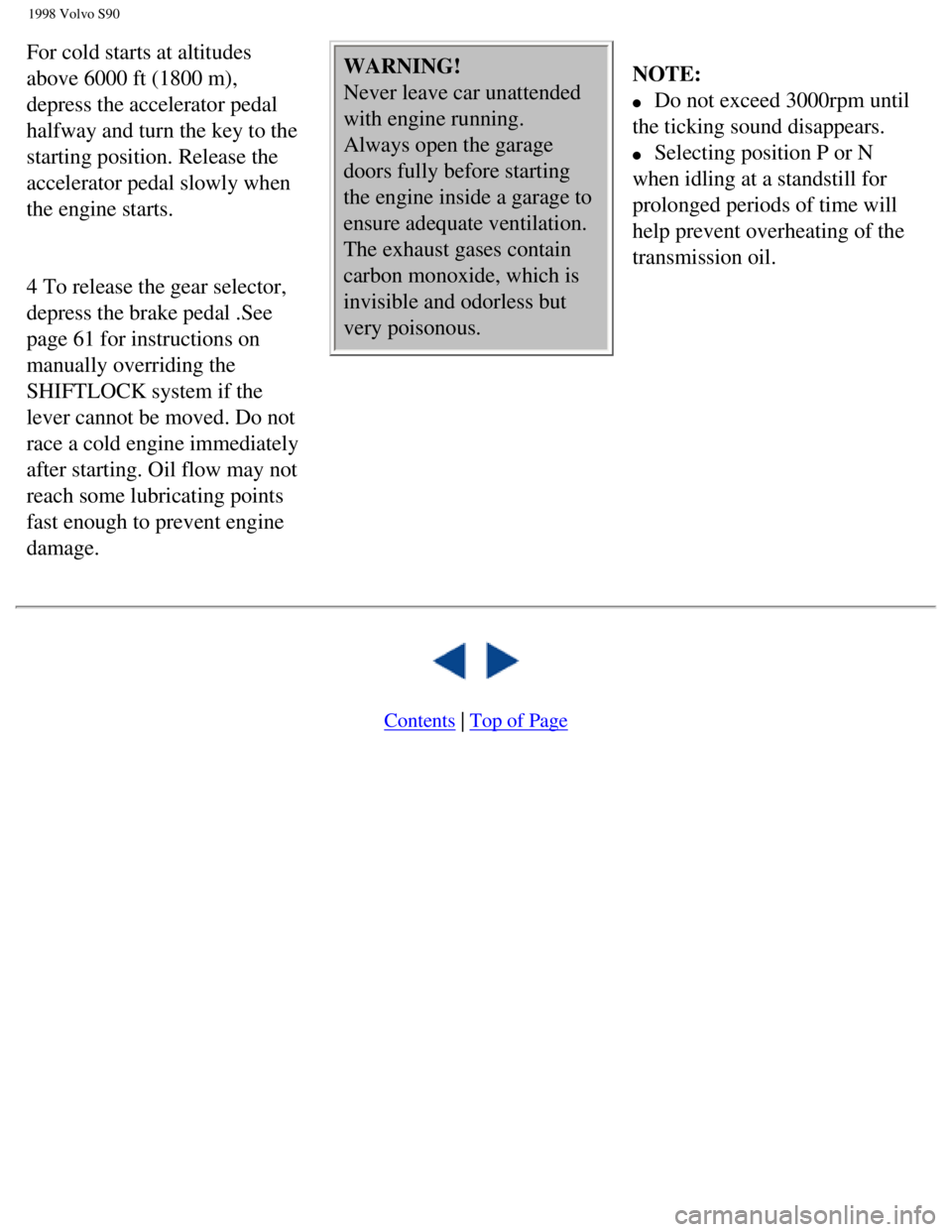
1998 Volvo S90
For cold starts at altitudes
above 6000 ft (1800 m),
depress the accelerator pedal
halfway and turn the key to the
starting position. Release the
accelerator pedal slowly when
the engine starts.
4 To release the gear selector,
depress the brake pedal .See
page 61 for instructions on
manually overriding the
SHIFTLOCK system if the
lever cannot be moved. Do not
race a cold engine immediately
after starting. Oil flow may not
reach some lubricating points
fast enough to prevent engine
damage. WARNING!
Never leave car unattended
with engine running.
Always open the garage
doors fully before starting
the engine inside a garage to
ensure adequate ventilation.
The exhaust gases contain
carbon monoxide, which is
invisible and odorless but
very poisonous.
NOTE:
l Do not exceed 3000rpm until
the ticking sound disappears.
l Selecting position P or N
when idling at a standstill for
prolonged periods of time will
help prevent overheating of the
transmission oil.
Contents | Top of Page
file:///K|/ownersdocs/1998/1998_SV90/98S90_053.htm (6 of 6)12/30/2006 \
1:52:41 PM
Page 66 of 175
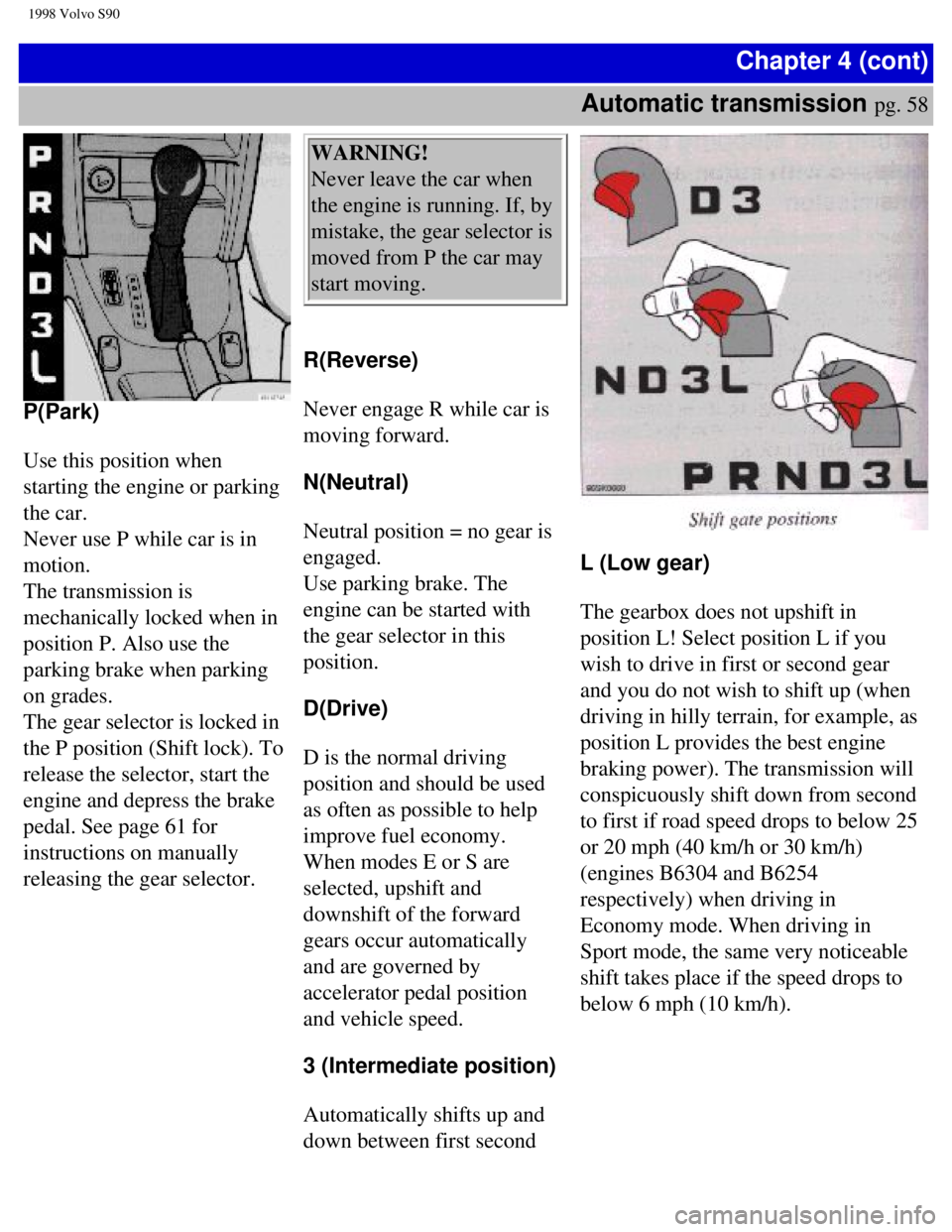
1998 Volvo S90
Chapter 4 (cont)
Automatic transmission
pg. 58
P(Park)
Use this position when
starting the engine or parking
the car.
Never use P while car is in
motion.
The transmission is
mechanically locked when in
position P. Also use the
parking brake when parking
on grades.
The gear selector is locked in
the P position (Shift lock). To
release the selector, start the
engine and depress the brake
pedal. See page 61 for
instructions on manually
releasing the gear selector. WARNING!
Never leave the car when
the engine is running. If, by
mistake, the gear selector is
moved from P the car may
start moving.
R(Reverse)
Never engage R while car is
moving forward.
N(Neutral)
Neutral position = no gear is
engaged.
Use parking brake. The
engine can be started with
the gear selector in this
position.
D(Drive)
D is the normal driving
position and should be used
as often as possible to help
improve fuel economy.
When modes E or S are
selected, upshift and
downshift of the forward
gears occur automatically
and are governed by
accelerator pedal position
and vehicle speed.
3 (Intermediate position)
Automatically shifts up and
down between first second
L (Low gear)
The gearbox does not upshift in
position L! Select position L if you
wish to drive in first or second gear
and you do not wish to shift up (when
driving in hilly terrain, for example, as
position L provides the best engine
braking power). The transmission will
conspicuously shift down from second
to first if road speed drops to below 25
or 20 mph (40 km/h or 30 km/h)
(engines B6304 and B6254
respectively) when driving in
Economy mode. When driving in
Sport mode, the same very noticeable
shift takes place if the speed drops to
below 6 mph (10 km/h).
file:///K|/ownersdocs/1998/1998_SV90/98S90_058.htm (1 of 7)12/30/2006 \
1:52:42 PM
Page 67 of 175
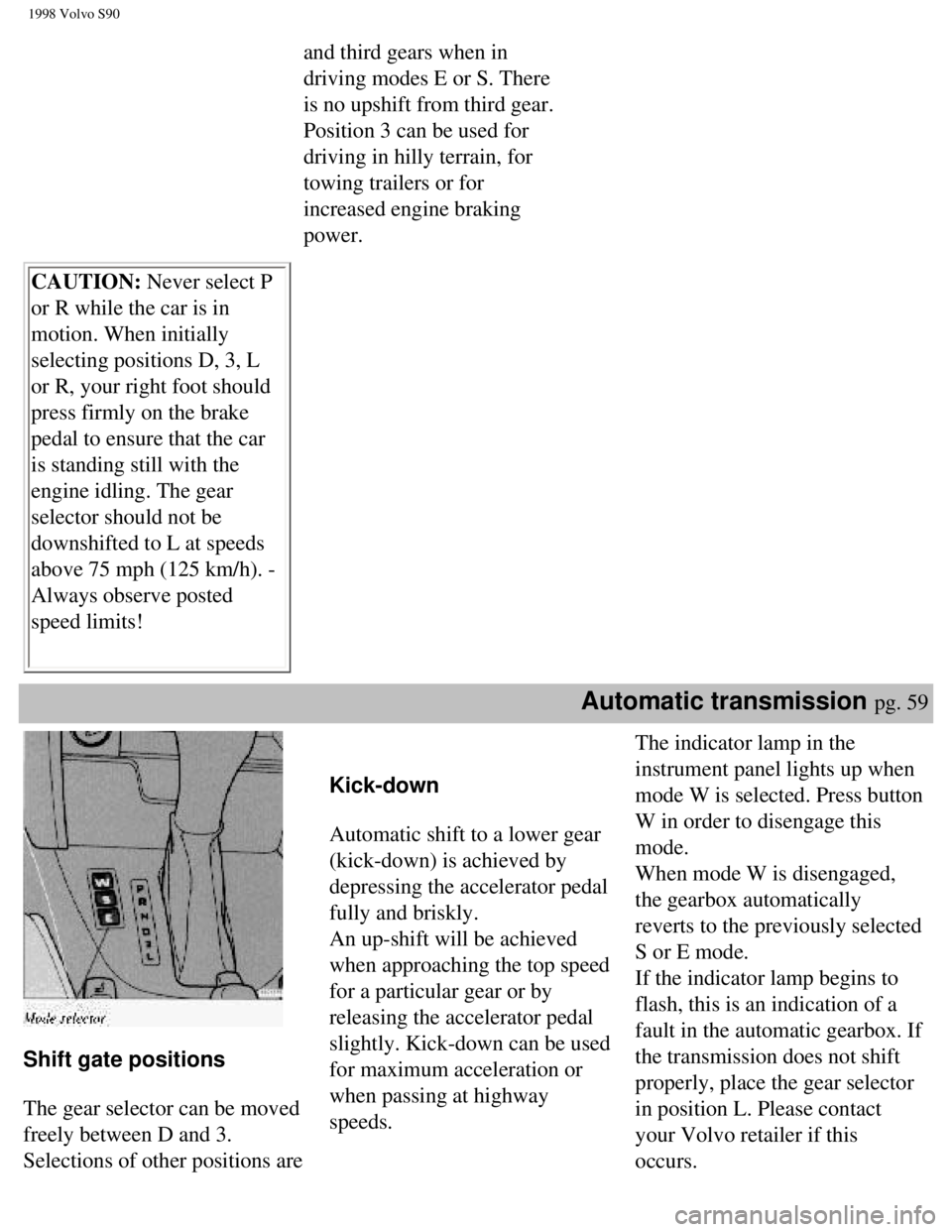
1998 Volvo S90
and third gears when in
driving modes E or S. There
is no upshift from third gear.
Position 3 can be used for
driving in hilly terrain, for
towing trailers or for
increased engine braking
power.
CAUTION: Never select P
or R while the car is in
motion. When initially
selecting positions D, 3, L
or R, your right foot should
press firmly on the brake
pedal to ensure that the car
is standing still with the
engine idling. The gear
selector should not be
downshifted to L at speeds
above 75 mph (125 km/h). -
Always observe posted
speed limits!
Automatic transmission pg. 59
Shift gate positions
The gear selector can be moved
freely between D and 3.
Selections of other positions are
Kick-down
Automatic shift to a lower gear
(kick-down) is achieved by
depressing the accelerator pedal
fully and briskly.
An up-shift will be achieved
when approaching the top speed
for a particular gear or by
releasing the accelerator pedal
slightly. Kick-down can be used
for maximum acceleration or
when passing at highway
speeds.
The indicator lamp in the
instrument panel lights up when
mode W is selected. Press button
W in order to disengage this
mode.
When mode W is disengaged,
the gearbox automatically
reverts to the previously selected
S or E mode.
If the indicator lamp begins to
flash, this is an indication of a
fault in the automatic gearbox. If
the transmission does not shift
properly, place the gear selector
in position L. Please contact
your Volvo retailer if this
occurs.
file:///K|/ownersdocs/1998/1998_SV90/98S90_058.htm (2 of 7)12/30/2006 \
1:52:42 PM
Page 68 of 175
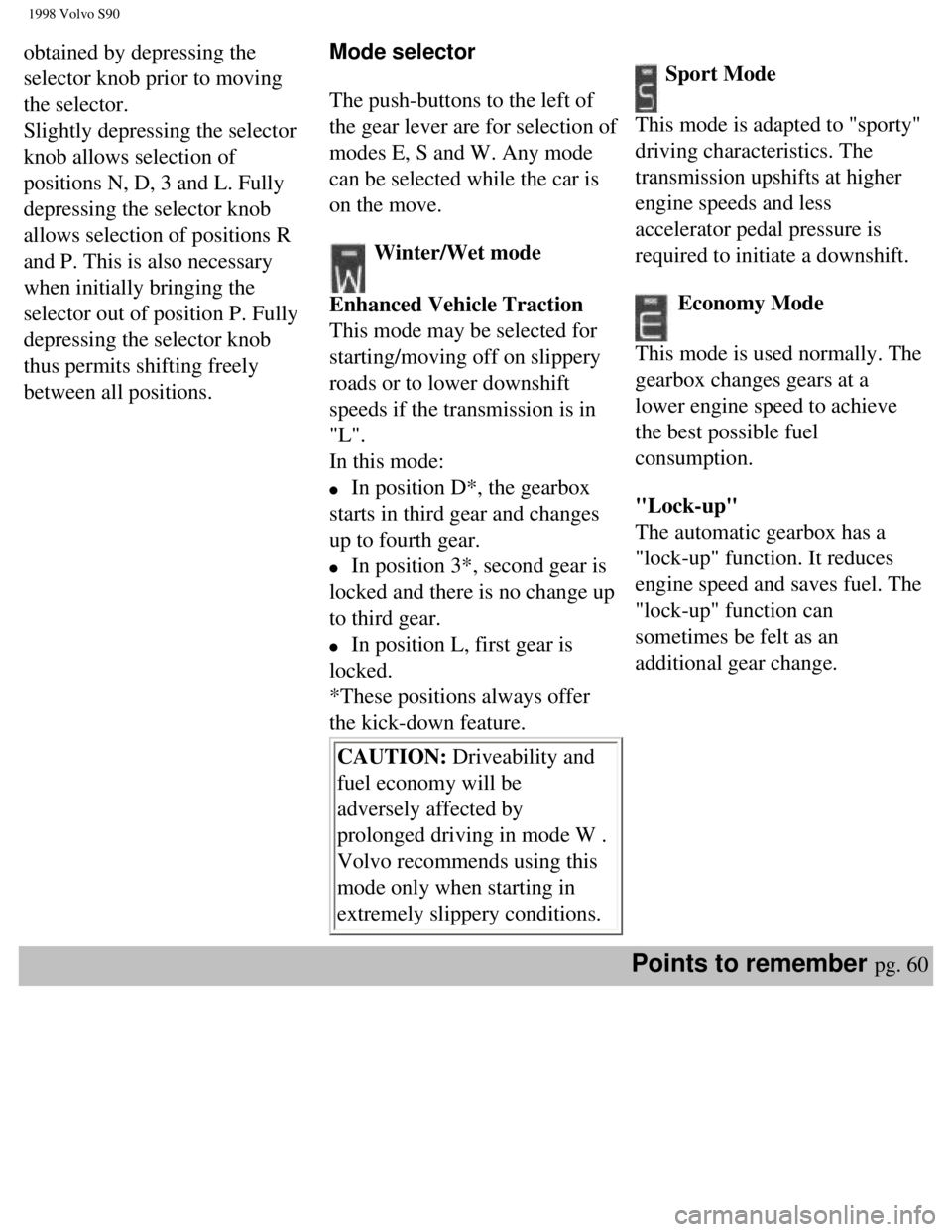
1998 Volvo S90
obtained by depressing the
selector knob prior to moving
the selector.
Slightly depressing the selector
knob allows selection of
positions N, D, 3 and L. Fully
depressing the selector knob
allows selection of positions R
and P. This is also necessary
when initially bringing the
selector out of position P. Fully
depressing the selector knob
thus permits shifting freely
between all positions.Mode selector
The push-buttons to the left of
the gear lever are for selection of
modes E, S and W. Any mode
can be selected while the car is
on the move.
Winter/Wet mode
Enhanced Vehicle Traction
This mode may be selected for
starting/moving off on slippery
roads or to lower downshift
speeds if the transmission is in
"L".
In this mode:
l In position D*, the gearbox
starts in third gear and changes
up to fourth gear.
l In position 3*, second gear is
locked and there is no change up
to third gear.
l In position L, first gear is
locked.
*These positions always offer
the kick-down feature.
CAUTION: Driveability and
fuel economy will be
adversely affected by
prolonged driving in mode W .
Volvo recommends using this
mode only when starting in
extremely slippery conditions.
Sport Mode
This mode is adapted to "sporty"
driving characteristics. The
transmission upshifts at higher
engine speeds and less
accelerator pedal pressure is
required to initiate a downshift.
Economy Mode
This mode is used normally. The
gearbox changes gears at a
lower engine speed to achieve
the best possible fuel
consumption.
"Lock-up"
The automatic gearbox has a
"lock-up" function. It reduces
engine speed and saves fuel. The
"lock-up" function can
sometimes be felt as an
additional gear change.
Points to remember pg. 60
file:///K|/ownersdocs/1998/1998_SV90/98S90_058.htm (3 of 7)12/30/2006 \
1:52:42 PM
Page 69 of 175

1998 Volvo S90
Special Tips - automatic transmission
l For driving down steep hills and when driving
for prolonged periods at low speeds, position L
should be selected. Avoid, however, repeated
changes since this can cause overheating of the
transmission oil. For driving on long continuous
uphill gradients, select position 3.
l Do not hold the car stationary on an incline by
using the accelerator pedal. Instead, apply the
hand brake (parking brake). This prevents the
transmission oil from becoming overheated.
l When towing a trailer, select shift position 3.
l The (E)conomy mode should be selected when
the cruise control is engaged.
l Never select P or R while the car is in motion.
l When initially selecting positions D, 3, L or R,
your right foot should press firmly on the brake
pedal to ensure that the car is standing still with
the engine idling.
l The gear selector should not be downshifted to
L at speeds above 75 mph (125 km/h). Always
observe posted speed limits. Cooling system
The risk for overheating is greatest, especially in
hot weather, when:
l towing a trailer up steep inclines for prolonged
periods at wide open throttle and low engine rpm.
l stopping the engine suddenly after high speed
driving (so-called "after-boiling" can occur).
To avoid overheating, the following rules should
be followed:
l Reduce speed and downshift when towing a
trailer up long, steep inclines. The risk of
overheating can be reduced by switching off the
air conditioning system for a short time.
l Do not let the engine idle unnecessarily for
prolonged periods.
l Do not mount auxiliary lamps in front of the
grill.
When the risk of overheating is imminent, or in
the event of overheating, (the temperature gauge
goes repeatedly into, or stays continually in, the
red section) the following precautions should be
taken:
l Switch off the air conditioning system.
l Pull off the road, away from traffic, stop the car
and put the gear lever into neutral. Do not stop the
engine!
l Switch the heater to full (maximum) position.
Increase the engine speed to approx. 2000 rpm
(twice idling speed) until the temperature begins
to drop.
See "Coolant" to check and top-up the coolant
level if necessary.
WARNING! Do not remove coolant expansion
tank cap. The coolant will be extremely hot.
Points to remember pg. 61
file:///K|/ownersdocs/1998/1998_SV90/98S90_058.htm (4 of 7)12/30/2006 \
1:52:42 PM
Page 70 of 175
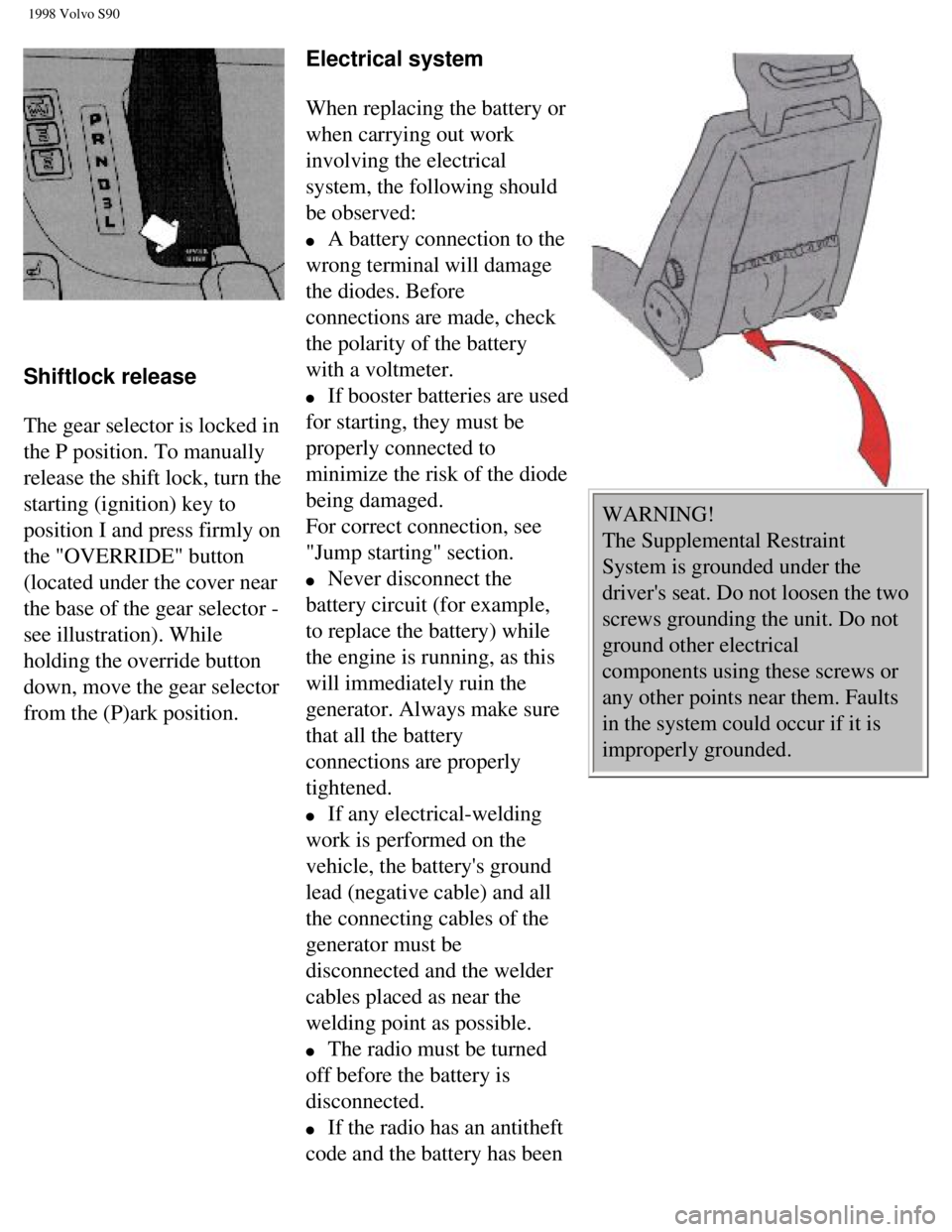
1998 Volvo S90
Shiftlock release
The gear selector is locked in
the P position. To manually
release the shift lock, turn the
starting (ignition) key to
position I and press firmly on
the "OVERRIDE" button
(located under the cover near
the base of the gear selector -
see illustration). While
holding the override button
down, move the gear selector
from the (P)ark position. Electrical system
When replacing the battery or
when carrying out work
involving the electrical
system, the following should
be observed:
l A battery connection to the
wrong terminal will damage
the diodes. Before
connections are made, check
the polarity of the battery
with a voltmeter.
l If booster batteries are used
for starting, they must be
properly connected to
minimize the risk of the diode
being damaged.
For correct connection, see
"Jump starting" section.
l Never disconnect the
battery circuit (for example,
to replace the battery) while
the engine is running, as this
will immediately ruin the
generator. Always make sure
that all the battery
connections are properly
tightened.
l If any electrical-welding
work is performed on the
vehicle, the battery's ground
lead (negative cable) and all
the connecting cables of the
generator must be
disconnected and the welder
cables placed as near the
welding point as possible.
l The radio must be turned
off before the battery is
disconnected.
l If the radio has an antitheft
code and the battery has been
WARNING!
The Supplemental Restraint
System is grounded under the
driver's seat. Do not loosen the two
screws grounding the unit. Do not
ground other electrical
components using these screws or
any other points near them. Faults
in the system could occur if it is
improperly grounded.
file:///K|/ownersdocs/1998/1998_SV90/98S90_058.htm (5 of 7)12/30/2006 \
1:52:42 PM